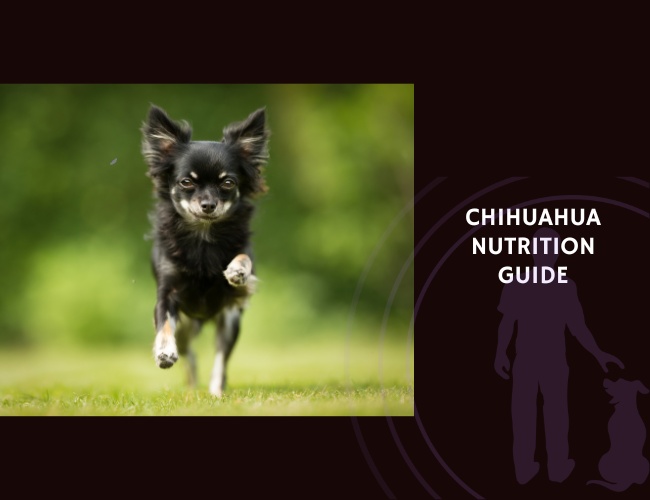Introduction: Understanding Your Chihuahua’s Unique Nutritional Journey
When you gaze into those large, expressive eyes of your Chihuahua, you’re looking at one of the world’s smallest dog breeds with one of the biggest nutritional challenges. These pint-sized companions, weighing between 2-6 pounds on average, carry within their tiny frames a metabolism that burns faster than a hummingbird’s wings. Did you know that your Chihuahua requires nearly twice the calories per pound compared to a large breed dog? This fascinating metabolic paradox makes understanding their nutritional needs not just important—it’s essential for their vibrant, healthy life.
Let us guide you through the intricate world of Chihuahua nutrition, where every kibble counts and each meal becomes an opportunity to support your furry friend’s wellbeing. From their ancient Toltec origins to modern-day lap companions, Chihuahuas have evolved with specific dietary requirements that, when properly addressed, can help them thrive well into their senior years—often reaching 14-18 years of age. 🧡
Breed-Specific Metabolism & Digestive Traits
Understanding Your Chihuahua’s Metabolic Engine
Your Chihuahua’s metabolism operates like a finely-tuned sports car—high-performance, energy-demanding, and requiring premium fuel. This elevated basal metabolic rate (BMR) means your tiny companion burns through calories at an impressive rate, requiring approximately 40 calories per pound of body weight daily—nearly double what a 50-pound dog needs per pound.
The Science Behind Their Speed: This metabolic intensity stems from their higher surface area to volume ratio. Simply put, your Chihuahua loses body heat more rapidly than larger dogs, requiring extra energy to maintain their core temperature of 101-102.5°F. You might notice your Chihuahua seeking warm spots or burrowing under blankets—this behavior directly relates to their metabolic demands.
Digestive System Characteristics: Their digestive tract, while proportionally similar to larger dogs, presents unique challenges:
- Stomach capacity: Approximately 10-15% of body weight
- Transit time: Food moves through their system in 8-10 hours
- Absorption efficiency: Slightly lower than medium-sized breeds due to rapid transit
This means your Chihuahua benefits from highly digestible, nutrient-dense foods that maximize absorption in their limited digestive timeframe.
Feeding Frequency: Why Small and Often Works Best
Unlike their larger cousins who might thrive on twice-daily feeding, your Chihuahua’s small stomach—roughly the size of a walnut—functions best with 3-4 small meals throughout the day. This feeding pattern prevents hypoglycemia, a condition Chihuahuas are particularly susceptible to due to their rapid metabolism and limited glycogen storage capacity.
Signs your feeding schedule needs adjustment:
- Morning lethargy or trembling
- Excessive begging between meals
- Vomiting yellow bile (indicating empty stomach)
- Energy crashes in late afternoon
The Obesity Paradox in Tiny Packages
Here’s where Chihuahua nutrition becomes particularly challenging: despite their high metabolic rate, these little dogs are surprisingly prone to obesity. Even an extra half-pound on a 4-pound Chihuahua represents a 12.5% weight increase—equivalent to a 150-pound person gaining nearly 19 pounds!
Why obesity happens so easily:
- Overestimation of caloric needs by well-meaning owners
- Treats that seem tiny to us but are substantial for them
- Reduced activity levels in indoor-only lifestyles
- Genetic predisposition to food-seeking behavior
Macronutrient Requirements: Building Blocks for Health
Protein: The Foundation of Vitality
Your Chihuahua’s protein needs vary significantly throughout their life journey. Think of protein as the construction material for everything from silky coat to strong muscles, requiring careful calibration at each life stage.
Life Stage Protein Requirements:
- Puppies (0-12 months): 25-28% dry matter basis
- Adults (1-7 years): 18-22% dry matter basis
- Seniors (7+ years): 20-25% dry matter basis
The slight increase in senior protein needs might surprise you, but maintaining muscle mass becomes crucial as your Chihuahua ages, helping preserve mobility and metabolic function.
Quality Over Quantity: Not all proteins are created equal. Your Chihuahua benefits most from:
- High biological value proteins (chicken, fish, eggs)
- Novel proteins for sensitive dogs (venison, duck, rabbit)
- Easily digestible sources with amino acid profiles matching canine needs
Fat: Energy and Essential Nutrients
Fat serves as your Chihuahua’s primary energy source, providing 2.25 times more calories per gram than protein or carbohydrates. But beyond energy, fats deliver essential fatty acids crucial for everything from brain function to that glossy coat you love to pet.
Optimal Fat Levels:
- Puppies: 15-20% dry matter basis
- Adults: 12-16% dry matter basis
- Seniors: 10-14% dry matter basis
The Omega Balance: Your Chihuahua’s inflammatory response, skin health, and cognitive function all depend on the delicate balance between omega-3 and omega-6 fatty acids. Aim for ratios between 1:5 to 1:10 (omega-3 to omega-6), though many commercial foods skew heavily toward omega-6.
Sources that support optimal ratios:
- Fish oil (salmon, sardine, anchovy)
- Flaxseed oil (though less bioavailable than fish sources)
- Chia seeds (ground for digestibility)
Carbohydrates: The Controversial Component
While dogs don’t have a specific carbohydrate requirement, these nutrients can provide readily available energy and beneficial fiber for your Chihuahua’s digestive health. The key lies in choosing the right types and amounts.
Beneficial Carbohydrate Sources:
- Low-glycemic options: Sweet potatoes, pumpkin, peas
- Digestible grains: Brown rice, oatmeal, quinoa
- Fiber sources: Psyllium husk, beet pulp (in moderation)
Warning Signs of Carbohydrate Intolerance:
- Excessive gas or bloating
- Loose stools or diarrhea
- Skin irritation or excessive scratching
- Weight gain despite controlled portions
Micronutrient Profile: The Hidden Heroes
Essential Vitamins for Chihuahua Health
Your tiny companion’s vitamin needs might be small in quantity but are mighty in importance. Each vitamin plays specific roles in maintaining their health, from supporting their keen eyesight to bolstering their immune defenses.
Critical Vitamins and Their Functions:
Vitamin A (Retinol):
- Supports those expressive eyes and night vision
- Maintains healthy skin and coat
- Daily requirement: 100 IU per kg body weight
Vitamin D (Calciferol):
- Essential for calcium absorption and bone health
- Particularly important given Chihuahuas’ susceptibility to luxating patellas
- Daily requirement: 10 IU per kg body weight
Vitamin E (Tocopherol):
- Powerful antioxidant protecting against cellular damage
- Supports immune function and skin health
- Daily requirement: 1-2 IU per kg body weight
B-Complex Vitamins:
- B1 (Thiamine): Nerve function and energy metabolism
- B12 (Cobalamin): Red blood cell formation and neurological health
- Folate: DNA synthesis and cell division
Mineral Balance: The Structural Support System
Minerals form the scaffolding of your Chihuahua’s body, from their delicate bones to their cellular processes. The balance between minerals is just as important as their individual presence.
Calcium and Phosphorus: The Dynamic Duo The calcium to phosphorus ratio should ideally be between 1.2:1 to 1.5:1. This balance is crucial for:
- Proper bone development and maintenance
- Muscle contraction and nerve signaling
- Blood clotting mechanisms
Trace Minerals with Major Impact:
- Zinc: Supports skin healing and immune function (15-30 mg daily for adults)
- Iron: Essential for oxygen transport (7-9 mg per kg of food)
- Selenium: Antioxidant properties and thyroid function (0.35 mg per kg of food)
- Manganese: Bone formation and metabolism (1.4 mg per kg of food)

Common Food Sensitivities and Intolerances
Recognizing the Signs
Your Chihuahua’s sensitive digestive system means food intolerances can manifest in various ways. Being attuned to these signals helps you identify problematic ingredients before they cause serious discomfort.
Gastrointestinal Symptoms:
- Vomiting within hours of eating
- Chronic diarrhea or soft stools
- Excessive gas or abdominal sounds
- Decreased appetite or food refusal
Dermatological Manifestations:
- Persistent scratching, especially around ears and paws
- Red, inflamed skin or hot spots
- Recurring ear infections
- Dull, flaky coat despite proper grooming
Behavioral Changes:
- Increased irritability after meals
- Lethargy or decreased activity
- Excessive licking of paws or surfaces
Common Culprits in Chihuahua Diets
Through veterinary observations and owner reports, certain ingredients repeatedly emerge as problematic for sensitive Chihuahuas:
Primary Allergens:
- Beef: The most common protein allergen in dogs
- Chicken: Despite being highly digestible, can trigger sensitivities
- Dairy products: Many Chihuahuas are lactose intolerant
- Wheat and corn: Common grain sensitivities
- Soy: Can cause both allergic and digestive reactions
The Elimination Diet Approach
If you suspect your Chihuahua has food sensitivities, an elimination diet provides the clearest path to identification. This process requires patience but yields invaluable insights.
Step-by-Step Process:
- Choose a novel protein and carbohydrate (e.g., venison and sweet potato)
- Feed exclusively for 8-12 weeks
- Monitor all symptoms carefully
- Gradually reintroduce suspected allergens one at a time
- Wait 2-3 weeks between new introductions
- Document any reactions meticulously
Life Stage Nutritional Adjustments
Puppy Nutrition: Building a Strong Foundation (0-12 months)
Your Chihuahua puppy’s nutritional needs during their first year lay the groundwork for lifelong health. These tiny bundles of energy require precise nutrition to support their rapid growth while avoiding developmental issues.
Growth Rate Considerations:
- Birth to 3 months: Most rapid growth phase
- 3-6 months: Continued development of bones and organs
- 6-12 months: Slowing growth, approaching adult size
Specific Puppy Requirements:
- Caloric density: 55-60 calories per pound body weight
- Calcium levels: 1.2-1.5% dry matter (avoiding excess that can cause skeletal problems)
- DHA supplementation: Supports brain and vision development
- Feeding frequency: 4-5 small meals daily until 6 months, then 3-4 meals
Adult Maintenance: The Balance Years (1-7 years)
Adult Chihuahuas have stabilized in their growth but maintain high metabolic demands. This stage focuses on maintaining ideal body condition while preventing obesity.
Maintenance Strategies:
- Caloric intake: 35-40 calories per pound for moderately active adults
- Body condition scoring: Aim for 4-5 on the 9-point scale
- Portion control: Use measuring cups, not visual estimates
- Treat management: Treats should not exceed 10% of daily calories
Activity Level Adjustments:
- Sedentary/indoor only: Reduce calories by 10-15%
- Moderately active: Standard recommendations
- Very active/agility dogs: Increase calories by 10-20%
Senior Support: Golden Years Nutrition (7+ years)
As your Chihuahua enters their senior years, their nutritional needs shift to support aging bodies while maintaining quality of life. You might notice your once-energetic companion slowing down, but proper nutrition can help them maintain vitality.
Age-Related Changes Requiring Nutritional Adaptation:
- Decreased metabolic rate (10-20% reduction)
- Reduced kidney and liver function
- Joint degeneration and arthritis development
- Dental issues affecting eating ability
- Cognitive changes requiring antioxidant support
Senior-Specific Nutritional Modifications:
- Protein: Maintain at 20-25% to preserve muscle mass
- Phosphorus: Reduce to 0.4-0.7% to support kidney function
- Fiber: Increase to 3-5% for digestive health
- Antioxidants: Enhance with vitamins E, C, and beta-carotene
- Joint support: Add glucosamine and chondroitin supplements
Reproductive Nutrition: Supporting Pregnancy and Lactation
If you’re breeding your Chihuahua, their nutritional needs dramatically increase during pregnancy and lactation. This delicate period requires careful monitoring and adjustment.
Pregnancy Nutrition Timeline:
- Weeks 1-4: Maintain normal adult diet
- Weeks 5-6: Increase calories by 25-30%
- Weeks 7-9: Increase calories by 50-60%
Lactation Demands:
- Peak lactation (weeks 3-4): May require 3-4 times maintenance calories
- Free-choice feeding often necessary
- High-quality puppy food recommended for nutrient density
- Calcium supplementation should be avoided (can cause eclampsia)
Tiny. Rapid. Refined.
Small body, huge demands.
Your Chihuahua’s metabolism is relentless—burning through calories faster than most breeds. Nutritional precision isn’t a luxury, it’s a requirement for survival and vibrance.
Fragility hides in routine.
Missed meals, oversized treats, or overlooked sensitivities can tip the balance. In a dog this small, one nutritional error echoes loudly across the system.



Vitality thrives in detail.
Micronutrient balance, omega ratios, and tailored feeding schedules transform fragility into resilience. This is not just feeding—this is fuelling a legacy in miniature.
Breed-Specific Health Risks with Nutritional Connections
Hypoglycemia: The Silent Threat
Hypoglycemia poses one of the most serious acute threats to Chihuahuas, particularly puppies and young adults. Understanding the nutritional management of this condition can be lifesaving.
Why Chihuahuas Are Vulnerable:
- Limited glycogen storage capacity
- High metabolic rate depleting glucose rapidly
- Small muscle mass reducing glucose reserves
- Stress or cold exposure accelerating glucose consumption
Nutritional Prevention Strategies:
- Complex carbohydrates: Provide sustained energy release
- Frequent feeding: Prevents glucose drops
- Emergency supplies: Keep corn syrup or honey available
- Protein pairing: Combine carbs with protein for stability
Dental Disease: The Hidden Nutrition Disruptor
Chihuahuas’ crowded teeth predispose them to dental disease, which can significantly impact their nutrition and overall health. By age 3, 80% of Chihuahuas show signs of periodontal disease.
Nutritional Approaches to Dental Health:
- Kibble size and texture: Appropriately sized for mechanical cleaning
- Dental chews: Enzymatic options that support oral health
- Raw bones: Under supervision, can provide natural cleaning
- Water additives: Antimicrobial solutions to reduce bacteria
When Dental Disease Affects Eating:
- Transition to softer foods temporarily
- Warm food slightly to enhance aroma
- Consider prescription dental diets
- Never ignore decreased eating due to dental pain
Luxating Patella: Supporting Joint Health
This common Chihuahua condition, where the kneecap dislocates, can be influenced by nutrition throughout life. While genetics play the primary role, nutritional support can minimize progression.
Joint-Supporting Nutrients:
- Glucosamine: 20 mg per pound body weight daily
- Chondroitin: 15 mg per pound body weight daily
- Omega-3 fatty acids: 20-30 mg EPA/DHA per pound
- MSM: 50 mg per dog daily
- Green-lipped mussel: Natural source of joint nutrients
Heart Conditions: Nutritional Cardiac Support
Chihuahuas show predisposition to various heart conditions, including mitral valve disease and patent ductus arteriosus. Nutrition plays a supportive role in management.
Cardiac Diet Principles:
- Sodium restriction: Moderate in early stages, strict in advanced disease
- Taurine supplementation: 250-500 mg daily
- L-carnitine: 50 mg per pound body weight daily
- Antioxidants: Protect cardiac muscle from oxidative stress
- Omega-3 fatty acids: Anti-inflammatory cardiac benefits
Recommended Feeding Methods and Diet Types
Commercial Kibble: Convenience with Consideration
Kibble remains the most popular feeding choice for Chihuahua owners, offering convenience and nutritional completeness when chosen carefully.
Selecting Quality Kibble:
- First ingredient: Named meat source (not by-products)
- Kibble size: Extra-small or toy breed specific
- Caloric density: 350-450 kcal per cup
- AAFCO certification: Ensures complete nutrition
- Limited ingredients: For sensitive dogs
Storage and Freshness:
- Buy smaller bags (used within 4-6 weeks)
- Store in airtight containers
- Check expiration dates religiously
- Avoid bulk buying that compromises freshness
Raw Feeding: The Ancestral Approach
Raw feeding, or BARF (Biologically Appropriate Raw Food), has gained popularity among Chihuahua owners seeking a more natural approach. This method requires dedication but can yield excellent results.
Raw Feeding Principles for Chihuahuas:
- Ratio balance: 80% meat, 10% bone, 10% organs
- Portion size: 2-3% of ideal body weight daily
- Variety rotation: Different protein sources weekly
- Safety protocols: Proper handling and storage essential
Special Considerations for Tiny Dogs:
- Grind bones finely to prevent choking
- Pre-portion meals for convenience
- Monitor stool quality closely
- Supplement with appropriate vitamins
Home-Cooked Diets: Love in Every Meal
Many Chihuahua owners express love through cooking, but home-prepared diets require careful formulation to avoid nutritional deficiencies.
Essential Components of Balanced Home-Cooked Meals:
- Protein: 40-50% of meal (cooked weight)
- Carbohydrates: 25-30% (sweet potato, brown rice)
- Vegetables: 15-20% (steamed or pureed)
- Fats: 10-15% (added oils or from protein)
- Supplements: Calcium, vitamins, trace minerals
Common Home-Cooking Mistakes:
- Over-reliance on muscle meat alone
- Inadequate calcium supplementation
- Excessive fat from human-grade cuts
- Lack of variety leading to deficiencies
Combination Feeding: The Best of All Worlds
Many successful Chihuahua owners employ combination feeding, mixing different diet types to maximize benefits while minimizing risks.
Popular Combinations:
- Morning kibble, evening home-cooked
- Kibble base with raw or fresh toppers
- Rotating between diet types weekly
- Seasonal adjustments (warming foods in winter)

Supplements and Nutraceuticals: Enhancing the Foundation
Core Supplements for Chihuahuas
While a balanced diet should provide most nutrients, certain supplements can address breed-specific needs or enhance overall health.
Recommended Daily Supplements:
Omega-3 Fatty Acids:
- Dosage: 20-30 mg EPA/DHA per pound
- Benefits: Anti-inflammatory, cognitive support, skin health
- Sources: Fish oil, krill oil, algae-based options
Probiotics:
- Dosage: 1-5 billion CFU daily
- Benefits: Digestive health, immune support
- Timing: With meals or as directed
Joint Support Complex:
- For prevention: Start at age 3-4
- For management: Higher doses under veterinary guidance
- Combination products often most effective
Condition-Specific Supplementation
For Anxiety-Prone Chihuahuas:
- L-theanine: 1-2 mg per pound
- Chamomile: As tea added to food
- CBD: Under veterinary supervision only
For Cognitive Support (Senior Dogs):
- SAMe: 10 mg per pound
- Vitamin E: 2 IU per pound
- MCT oil: 1/4 teaspoon daily
For Digestive Sensitivity:
- Digestive enzymes with meals
- Slippery elm: 1/8 teaspoon per meal
- Pumpkin: 1/2 teaspoon for fiber
Practical Feeding Guidelines for Owners
Creating the Ideal Feeding Environment
Your Chihuahua’s eating experience extends beyond just the food—the environment plays a crucial role in their nutritional success.
Setting Up for Success:
- Quiet location: Away from high-traffic areas
- Elevated feeders: Reduces neck strain
- Non-slip mats: Prevents bowl sliding
- Consistent timing: Same location, same schedule
- Temperature control: Warm area for comfortable eating 🐾
Addressing Common Feeding Challenges
The Picky Eater Dilemma: Chihuahuas are notorious for developing finicky eating habits. Here’s how to manage:
- Rule out medical issues first
- Limit meal availability to 15-20 minutes
- Avoid constant food changes
- Warm food slightly to enhance aroma
- Use food puzzles for mental stimulation
Food Aggression and Resource Guarding: Despite their size, some Chihuahuas develop protective behaviors around food.
Management strategies:
- Hand-feeding to build positive associations
- Trading games with high-value treats
- Multiple small meals reducing perceived scarcity
- Professional help for severe cases
Transitioning Foods Safely
When changing your Chihuahua’s diet, their sensitive digestive system demands a gradual approach.
The 10-Day Transition Protocol:
- Days 1-3: 75% old food, 25% new food
- Days 4-6: 50% old food, 50% new food
- Days 7-9: 25% old food, 75% new food
- Day 10: 100% new food
Monitor for transition issues:
- Loose stools (slow the transition)
- Vomiting (may indicate intolerance)
- Decreased appetite (ensure palatability)
- Behavioral changes (stress or discomfort)
Special Circumstances and Considerations
- Separate feeding areas prevent competition
- Baby gates allow visual contact without food theft
- Different feeding heights for different sized pets
- Monitor to ensure each pet eats appropriately
Travel Nutrition:
- Maintain regular feeding schedule across time zones
- Pack familiar food to avoid digestive upset
- Portable water and food bowls
- Emergency food supply for delays
Monitoring and Adjusting: The Ongoing Journey
Body Condition Scoring for Chihuahuas
Regular body condition assessment ensures your feeding plan keeps your Chihuahua at optimal weight. Their small size makes even minor weight changes significant.
How to Assess:
- Rib check: Easily felt but not visible
- Waist visibility: Clear when viewed from above
- Abdominal tuck: Evident from side view
- Energy levels: Consistent throughout day
- Coat quality: Shiny and smooth
When to Adjust the Plan
Your Chihuahua’s nutritional needs aren’t static—they change with seasons, activity, and life events.
Adjustment triggers:
- Weight gain or loss exceeding 5%
- Changes in activity level
- Seasonal temperature variations
- Medical conditions or medications
- Dental issues affecting eating
Working with Your Veterinarian
Partnership with your veterinarian ensures optimal nutrition throughout your Chihuahua’s life. Regular check-ups should include nutritional assessments.
Important discussions to have:
- Annual bloodwork to detect deficiencies
- Body condition scoring together
- Supplement recommendations
- Diet modifications for health conditions
- Preventive nutrition strategies
Conclusion: Nourishing Your Tiny Companion’s Big Life
As we conclude this comprehensive journey through Chihuahua nutrition, remember that feeding your tiny companion is both an art and a science. These remarkable little dogs, with their larger-than-life personalities packed into petite frames, depend on you to make nutritional choices that support their unique metabolic needs, prevent breed-specific health issues, and enhance their quality of life.
The path to optimal Chihuahua nutrition isn’t always straightforward—it requires observation, adjustment, and sometimes a bit of creative problem-solving. But when you see your Chihuahua thriving with bright eyes, a glossy coat, steady energy, and that characteristic confident prance, you’ll know your efforts are worthwhile.
Key Takeaways to Remember:
- Small size means every calorie and nutrient counts
- Frequent, small meals prevent hypoglycemia
- Life stage adjustments are crucial for long-term health
- Quality over quantity in all food choices
- Individual needs may vary—stay observant and flexible
Your Chihuahua may be small, but their impact on your life is enormous. By providing them with optimal nutrition tailored to their unique needs, you’re not just feeding a pet—you’re nourishing a cherished family member who will reward your care with years of devoted companionship, endless entertainment, and unconditional love. Here’s to many happy, healthy years with your perfectly nourished Chihuahua! 🧡










